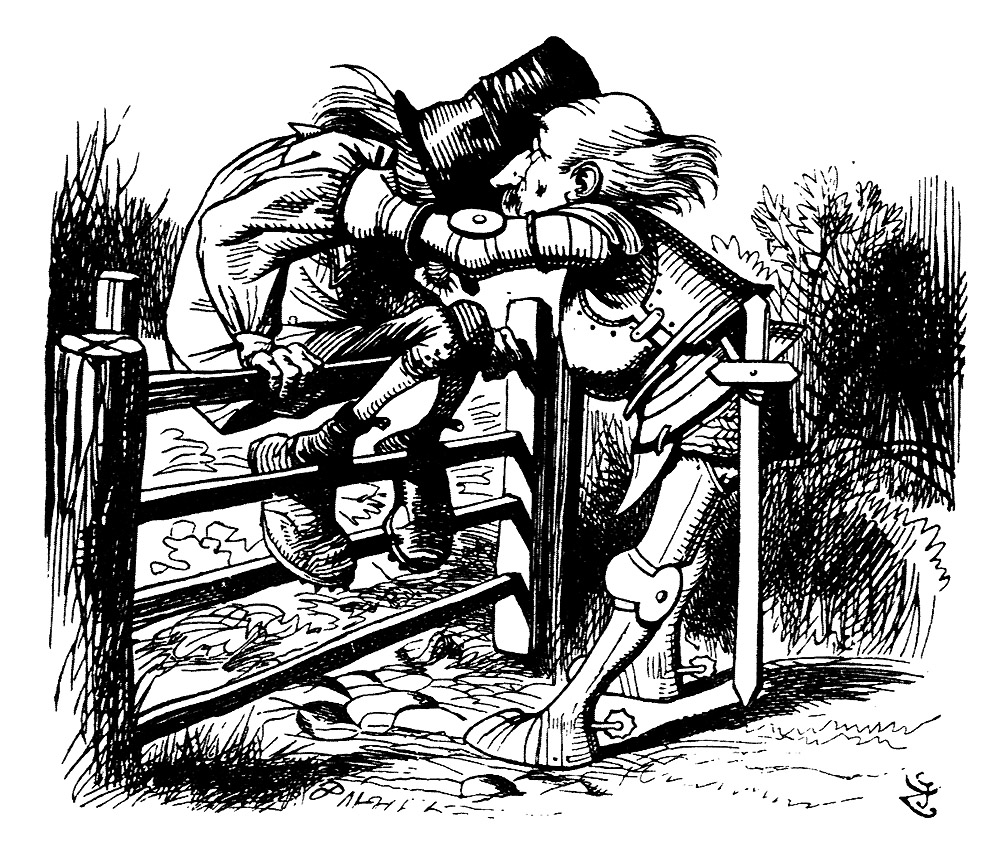Haddocks' Eyes on:
[Wikipedia]
[Google]
[Amazon]
 "Haddocks' Eyes" is the nickname of the name of a song sung by The White Knight from
"Haddocks' Eyes" is the nickname of the name of a song sung by The White Knight from
 "Haddocks' Eyes" is the nickname of the name of a song sung by The White Knight from
"Haddocks' Eyes" is the nickname of the name of a song sung by The White Knight from Lewis Carroll
Charles Lutwidge Dodgson (27 January 1832 – 14 January 1898), better known by his pen name Lewis Carroll, was an English author, poet, mathematician, photographer and reluctant Anglicanism, Anglican deacon. His most notable works are ''Alice ...
's 1871 novel ''Through the Looking-Glass
''Through the Looking-Glass, and What Alice Found There'' is a novel published in December 1871 by Lewis Carroll, the pen name of Charles Lutwidge Dodgson, a mathematics lecturer at Christ Church, Oxford, Christ Church, University of Oxford. I ...
'', chapter VIII.
"Haddocks' Eyes" is an example used to elaborate on the symbolic status of the concept of "name
A name is a term used for identification by an external observer. They can identify a class or category of things, or a single thing, either uniquely, or within a given context. The entity identified by a name is called its referent. A person ...
": a name as identification marker may be assigned to anything, including another name, thus introducing different levels of symbolization. It has been discussed in several works on logic and philosophy.
Haddock's Eyes
The White Knight explains to Alice a confusing nomenclature for the song. To summarize: *The song's name is called ''Haddocks' Eyes'' *The song's name is ''The Aged Aged Man'' *The song is called ''Ways and Means'' *The song is ''A-sitting on a Gate'' The complicated terminology distinguishing between 'the song, what the song is called, the name of the song, and what the name of the song is called' both uses and mentions theuse–mention distinction
In analytic philosophy, a fundamental distinction is made between the use of a term and the mere mention of it.Devitt and Sterelny (1999) pp. 40–1. W. V. O. Quine (1940) p. 24. Many philosophical works have been "vitiated by a failure ...
.
The song
The White Knight sings the song to a tune he claims as his own invention, but which Alice recognises as " I give thee all, I can no more". By the time Alice heard it, she was already tired of poetry. The song parodies the plot, but not the style or metre, of " Resolution and Independence" byWilliam Wordsworth
William Wordsworth (7 April 177023 April 1850) was an English Romantic poetry, Romantic poet who, with Samuel Taylor Coleridge, helped to launch the Romanticism, Romantic Age in English literature with their joint publication ''Lyrical Balla ...
.
Upon the Lonely Moor
Like "Jabberwocky
"Jabberwocky" is a Nonsense verse, nonsense poem written by Lewis Carroll about the killing of a creature named "the Jabberwock". It was included in his 1871 novel ''Through the Looking-Glass'', the sequel to ''Alice's Adventures in Wonderland' ...
", another poem published in ''Through the Looking Glass'', "Haddocks' Eyes" appears to have been revised over the course of many years. In 1856, Carroll published the following poem anonymously under the name ''Upon the Lonely Moor''. It bears an obvious resemblance to "Haddocks' Eyes".
See also
*Nonsense verse
Nonsense verse is a form of nonsense literature usually employing strong prosodic elements like rhythm and rhyme. It is often whimsical and humorous in tone and employs some of the techniques of nonsense literature.
Limericks are probably th ...
References
{{Alice, state=expanded British poems British humorous poems 1871 poems Alice's Adventures in Wonderland Nonsense poetry Parodies of literature